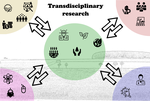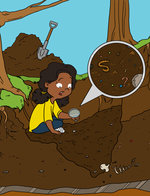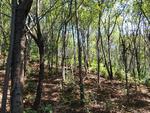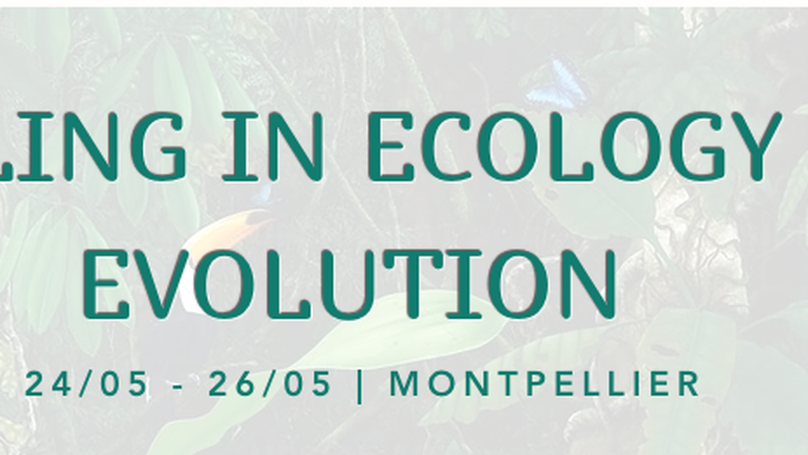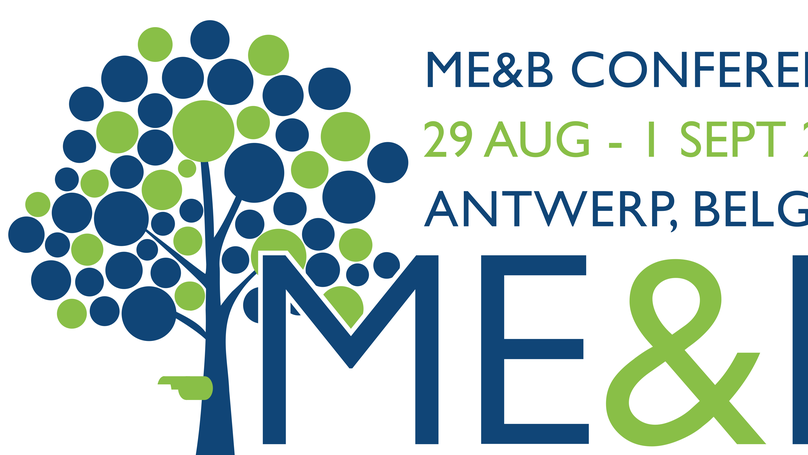About me
My research lies at the intersection of biodiversity, microclimate, and ecosystem functioning, with a particular focus on how plant diversity modulates microclimate and, in turn, shapes forest carbon dynamics. This dual focus has positioned me in a rapidly emerging research field that seeks to integrate microclimatic processes into our understanding of BEF relationships and carbon cycling under global change.
I began my academic trajectory in agricultural engineering before transitioning into ecology and evolution during my final year, with a master’s thesis on species interaction modelling (ISEM, Montpellier). This foundation led to my Ph.D. at iDiv (Germany), where I investigated tree-tree interactions and the influence of tree species richness on forest carbon cycling. My doctoral research highlighted how biodiversity positively affects litterfall, decomposition, soil carbon storage, and microbial functioning.
Recognizing microclimate as a key but underexplored driver of these processes, I pivoted my postdoctoral research toward microclimate science. I conducted a global analysis of how plant diversity shapes understory microclimates using data from BEF experiments, in collaboration with the Leipzig Institute of Meteorology (LIM, in prep., but see Schnabel, Beugnon et al., 2025). This work directly informs the hypothesis that biodiversity affects forest carbon not only through biotic interactions but also via its role in modulating microclimatic conditions.
To advance this emerging field, I have taken on an active leadership role in the microclimate research community. I serve on the scientific and practical committees of the Microclimate in Ecology and Biogeography (MEB) global network of microclimate researchers, contribute to methodological development (e.g., De Frenne et al. 2024; Gross MSc thesis; the Microclimate Database: https://meb-network.com/access-to-the-database/), and have helped develop new theoretical frameworks linking microclimate, biodiversity, and ecosystem functioning (Beugnon et al. 2021, 2024; Kemppinen et al. 2024). These activities have laid the conceptual and collaborative foundations for the integrative and interdisciplinary approach in my projects.
Publications (2019-2025): I have authored 28 peer-reviewed articles, including in Nature Communications, Science Advances, Ecological Monographs, Ecology Letters, and Global Change Biology.
Supervision (2019-2025): I have co-supervised 2 PhD students and mentored 4 MSc, 2 BSc, 1 ENS Lyon gap-year, and 2 IUT Perpignan final-year students.
Teaching: I lectured in Ecology, Biodiversity, and Statistics at the bachelor’s and master’s levels (2021–2025), including module coordination.
Scientific Expertise: I contributed to a European Commission technical review on the Soil Monitoring Law (led by Dr. Carlos Guerra).
Community Engagement: As a member of the MEB steering committee, I support network organization, scientific animation, and community development through biannual committee meetings and active collaboration.
Outreach: I was interviewed by EOS (AGU) as a BEF expert (Sidik, 2023), and co-edited the Frontiers for Young Minds eBook Soil Biodiversity, featuring 33 articles by 50 scientists and translated into 22+ languages (Beugnon et al., 2022; 2024).
Peer Review: I serve as a reviewer for top-tier journals, including Ecology Letters, Functional Ecology, Global Change Biology, and Nature Communications.
My research
100%
60%
40%
50%
70%
100%
Projects
Recent Posts
Featured Publications
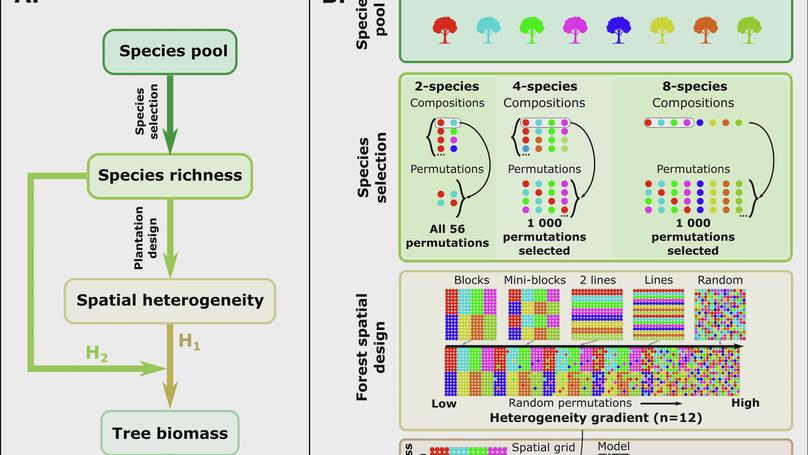
Reforestation and afforestation programs are promoted as strategies to mitigate rising atmospheric CO2 concentrations and enhance ecosystem services. Planting diverse forests is supposed to foster such benefits, but optimal tree planting techniques, especially regarding species spatial arrangement, are underexplored. Here, using field measurements from the subtropical BEF-China experiment, we simulate tree growth, leaf litterfall, and decomposition, as a function of various spatial arrangements of tree species, from clusters of species to random distributions. Our simulations suggest that increasing tree species spatial heterogeneity in forests composed of eight tree species leads to higher biomass production, more evenly distributed litterfall, increased litter decomposition, and associated nitrogen and carbon cycling. These effects on forest nutrient dynamics are amplified with increasing species richness. Our data show that the spatial arrangement of tree species is a critical component determining biodiversity-ecosystem functioning relationships. Therefore, we suggest the explicit consideration of spatial arrangements when planting trees for reforestation and afforestation projects.
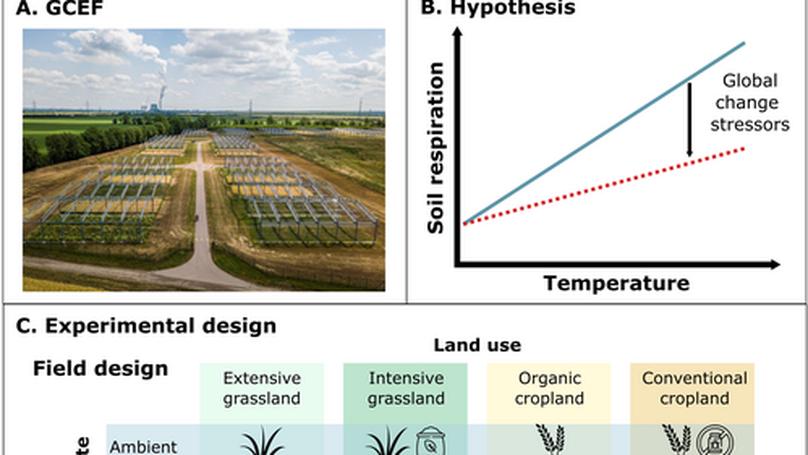
Soil microbial communities provide numerous ecosystem functions, such as nutrient cycling, decomposition, and carbon storage. However, global change, including land-use and climate changes, affects soil microbial communities and activity. As extreme weather events (e.g., heatwaves) tend to increase in magnitude and frequency, we investigated the effects of heat stress on the activity (e.g., respiration) of soil microbial communities that had experienced four different long-term land-use intensity treatments (ranging from extensive grassland and intensive grassland to organic and conventional croplands) and two climate conditions (ambient vs. predicted future climate). We hypothesized that both intensive land use and future climate conditions would reduce soil microbial respiration (H1) and that experimental heat stress would increase microbial respiration (H2). However, this increase would be less pronounced in soils with a long-term history of high-intensity land use and future climate conditions (H3), and soils with a higher fungal-to-bacterial ratio would show a more moderate response to warming (H4). Our study showed that soil microbial respiration was reduced under high land-use intensity (i.e., −43% between extensive grassland and conventional cropland) and future climate conditions (−12% in comparison to the ambient climate). Moreover, heat stress increased overall microbial respiration (+17% per 1°C increase), while increasing land-use intensity reduced the strength of this response (−25% slope reduction). In addition, increasing soil microbial biomass and fungal-to-bacterial ratio under low-intensity land use (i.e., extensive grassland) enhanced the microbial respiration response to heat stress. These findings show that intensive land use and climate change may compromise the activity of soil microbial communities as well as their respiration under heatwaves. In particular, soil microbial communities under high-intensity land use and future climate are less able to respond to additional stress, such as heatwaves, potentially threatening the critical ecosystem functions driven by soil microbes and highlighting the benefits of more sustainable agricultural practices.
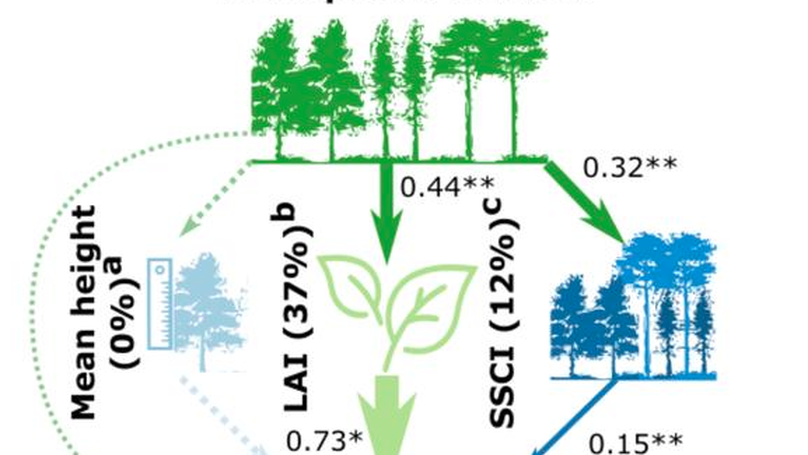
Global warming is increasing the frequency and intensity of climate extremes. Forests may buffer climate extremes by creating their own attenuated microclimate below their canopy, which maintains forest functioning and biodiversity. However, the effect of tree diversity on temperature buffering in forests is largely unexplored. Here, we show that tree species richness increases forest temperature buffering across temporal scales over six years in a large-scale tree diversity experiment covering a species richness gradient of 1 to 24 tree species. We found that species richness strengthened the cooling of hot and the insulation against cold daily and monthly air temperatures and temperature extremes. This buffering effect of tree species richness was mediated by enhanced canopy density and structural diversity in species-rich stands. Safeguarding and planting diverse forests may thus mitigate negative effects of global warming and climate extremes on below-canopy ecosystem functions and communities.

Changes in climate and biodiversity are widely recognized as primary global change drivers of ecosystem structure and functioning, also affecting ecosystem services provided to human populations. Increasing plant diversity not only enhances ecosystem functioning and stability but also mitigates climate change effects and buffers extreme weather conditions, yet the underlying mechanisms remain largely unclear. Recent studies have shown that plant diversity can mitigate climate change (e.g. reduce temperature fluctuations or drought through microclimatic effects) in different compartments of the focal ecosystem, which as such may contribute to the effect of plant diversity on ecosystem properties and functioning. However, these potential plant diversity-induced microclimate effects are not sufficiently understood. Here, we explored the consequences of climate modulation through microclimate modification by plant diversity for ecosystem functioning as a potential mechanism contributing to the widely documented biodiversity–ecosystem functioning (BEF) relationships, using a combination of theoretical and simulation approaches. We focused on a diverse set of response variables at various levels of integration ranging from ecosystem-level carbon exchange to soil enzyme activity, including population dynamics and the activity of specific organisms. Here, we demonstrated that a vegetation layer composed of many plant species has the potential to influence ecosystem functioning and stability through the modification of microclimatic conditions, thus mitigating the negative impacts of climate extremes on ecosystem functioning. Integrating microclimatic processes (e.g. temperature, humidity and light modulation) as a mechanism contributing to the BEF relationships is a promising avenue to improve our understanding of the effects of climate change on ecosystem functioning and to better predict future ecosystem structure, functioning and services. In addition, microclimate management and monitoring should be seen as a potential tool by practitioners to adapt ecosystems to climate change.
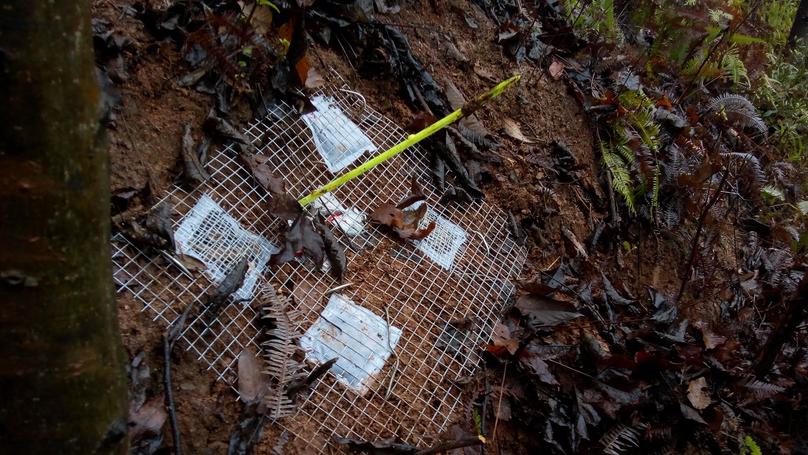
Reforestation and afforestation programs are promoted as strategies to mitigate rising atmospheric CO2 concentrations and enhance ecosystem services. Planting diverse forests is supposed to foster such benefits, but optimal tree planting techniques, especially regarding species spatial arrangement, are underexplored. Here, using field measurements from the subtropical BEF-China experiment, we simulated leaf litterfall and decomposition, as a function of various spatial arrangements of tree species, from clusters of species to random distributions. We show that increasing tree species spatial heterogeneity in forests composed of nine tree species led to more evenly distributed litterfall, increased litter decomposition and associated nitrogen cycling by 45%. These effects were amplified with increasing plot species richness, while species functional trait identity and diversity modulated these relationships. The spatial arrangement of tree species is a critical component determining biodiversity ecosystem functioning relationships, and considering such spatial aspects is crucial for operationalizing biodiversity-ecosystem functioning theory in realistic re-/afforestation projects

Forest ecosystems are critical for their carbon sequestration potential. Increasing tree diversity has been shown to enhance both forest productivity and litter decomposition. Litter diversity increases litter decomposability by increasing the diversity of substrates offered to decomposers. However, the relative importance of litter decomposability and decomposer community in mediating tree diversity effects on decomposition remains unknown. Moreover, tree diversity modulation of litterfall spatial distribution, and consequently litter decomposition, has rarely been tested. We studied tree diversity effects on leaf litter decomposition and its mediation by the amount of litterfall, litter species richness and decomposability, and soil microorganisms in a large-scale tree diversity experiment in subtropical China. Furthermore, we examined how litter functional identity and diversity affect leaf litter decomposability. Finally, we tested how leaf functional traits, tree biomass, and forest spatial structure drive the litterfall spatial distribution. We found evidence that tree species richness increased litter decomposition by increasing litter species richness and the amount of litterfall. We showed that soil microorganisms in this subtropical forest perform 84–87% of litter decomposition. Moreover, changes in the amount of litterfall and microbial decomposition explained 19–37% of the decomposition variance. Additionally, up to 20% of the microbial decomposition variance was explained by litter decomposability, while litter decomposability itself was determined by litter functional identity, diversity, and species richness. Tree species richness increased litter species richness and the amount of litterfall (+200% from monoculture to eight-species neighborhood). We further demonstrated that the amount of species-specific litterfall increased with increasing tree proximity and biomass, and was modulated by leaf functional traits. These litterfall drivers increased the spatial heterogeneity of litter distribution, and thus litter decomposition. We highlighted multiple biomass- and diversity-mediated effects of tree diversity on ecosystem properties driving forest nutrient cycling. We conclude that considering spatial variability in biotic properties will improve our mechanistic understanding of ecosystem functioning.
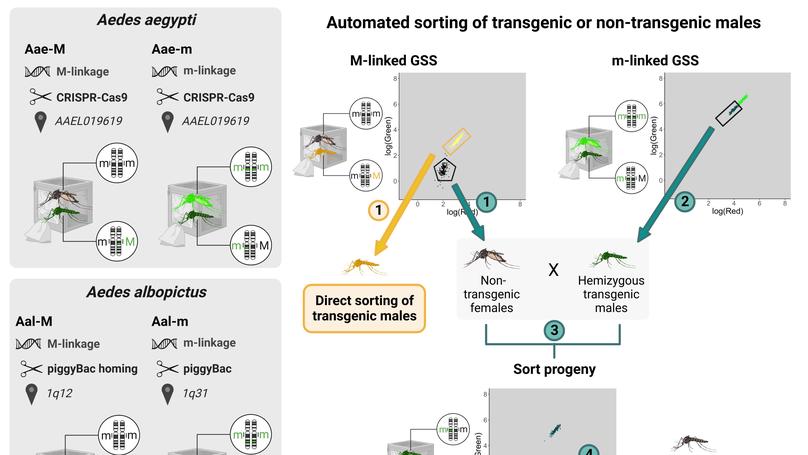
Chemical control of disease vectoring mosquitoes Aedes albopictus and Aedes aegypti is costly, unsustainable, and increasingly ineffective due to the spread of insecticide resistance. The Sterile Insect Technique is a valuable alternative but is limited by slow, error-prone, and wasteful sex-separation methods. Here, we present four Genetic Sexing Strains (two for each Aedes species) based on fluorescence markers linked to the m and M sex loci, allowing for the isolation of transgenic males. Furthermore, we demonstrate how combining these sexing strains enables the production of non-transgenic males. In a mass-rearing facility, 100,000 first instar male larvae could be sorted in under 1.5h with an estimated 0.01–0.1% female contamination on a single machine. Cost-efficiency analyses revealed that using these strains could result in important savings while setting up and running a mass-rearing facility. Altogether, these Genetic Sexing Strains should enable a major upscaling in control programmes against these important vectors.
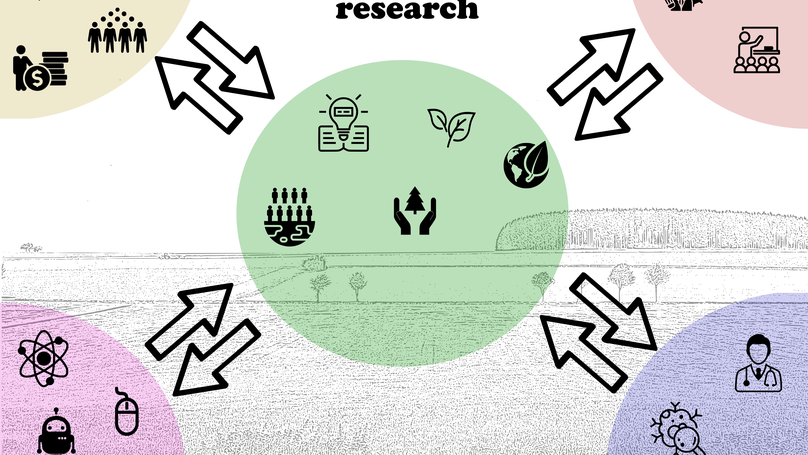
Zu den Herausforderungen unserer Gesellschaft gehören eine Vielzahl von Krisen. Derzeitige disziplinäre Forschungsprojekte reichen möglicherweise nicht aus, um die vielfältigen Herausforderungen zu bewälti- gen, mit denen die Welt konfrontiert ist. Wie können Forschende ein solches Vorhaben angehen, wenn sie sich gerade erst in ihrer Kerndisziplin orientieren? Um das herauszufinden, haben wir ausführliche, halb- strukturierte Interviews mit sechs etablierten Forschenden geführt, die am Schnittpunkt verschiedener Disziplinen arbeiten und Erfahrungen mit dieser Herausforderung haben.
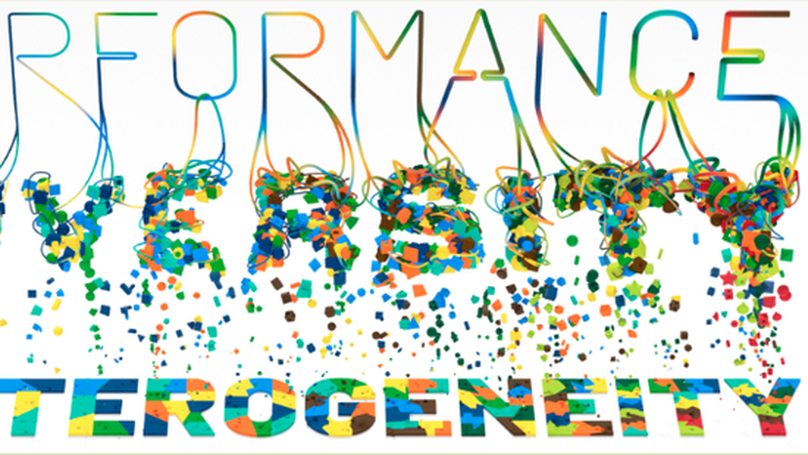
Ever-growing human population and nutritional demands, supply chain disruptions, and advancing climate change have led to the realization that changes in diversity and system performance are intimately linked. Moreover, diversity and system performance depend on heterogeneity. Mitigating changes in system performance and promoting sustainable living conditions requires transformative decisions. Here, we introduce the heterogeneity-diversity-system performance (HDP) nexus as the conceptual basis upon which to formulate transformative decisions. We suggest that managing the heterogeneity of systems will best allow diversity to provide multiple benefits to people. Based on ecological theory, we pose that the HDP nexus is broadly applicable across systems, disciplines, and sectors, and should thus be considered in future decision making as a way to have a more sustainable global future.
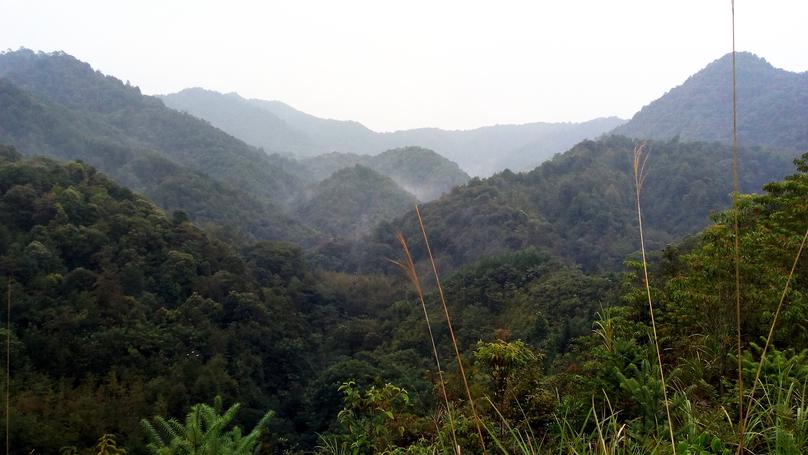
Forests are critical ecosystems to understand the global carbon budget, due to their carbon sequestration potential in both above- and belowground compartments, especially in species-rich forests. Soil carbon sequestration is strongly linked to soil microbial communities, and this link is mediated by the tree community, likely due to modifications of micro-environmental conditions (i.e., biotic conditions, soil properties, and microclimate). We studied soil carbon concentration and the soil microbial biomass of 180 local neighborhoods along a gradient of tree species richness ranging from 1 to 16 tree species per plot in a Chinese subtropical forest experiment (BEF-China). Tree productivity and different tree functional traits were measured at the neighborhood level. We tested the effects of tree productivity, functional trait identity and dissimilarity on soil carbon concentrations, and their mediation by the soil microbial biomass and micro-environmental conditions. Our analyses showed a strong positive correlation between soil microbial biomass and soil carbon concentrations. Besides, soil carbon concentration increased with tree productivity and tree root diameter while it decreased with litterfall C:N content. Moreover, tree productivity and tree functional traits (e.g. root fungal association and litterfall C:N ratio) modulated micro-environmental conditions with substantial consequences for soil microbial biomass. We also showed that soil history and topography should be considered in future experiments and tree plantations, as soil carbon concentrations were higher where historical (i.e., at the beginning of the experiment) carbon concentrations were high, themselves being strongly affected by the topography. Altogether, these results imply that the quantification of the different soil carbon pools is critical for understanding microbial community–soil carbon stock relationships and their dependence on tree diversity and micro-environmental conditions. This article is protected by copyright. All rights reserved.

Global change is affecting soil biodiversity and functioning across all terrestrial ecosystems. Still, much is unknown about how soil biodiversity and function will change in the future in response to simultaneous alterations in climate and land use, as well as other environmental drivers. It is crucial to understand the direct, indirect and interactive effects of global change drivers on soil communities and ecosystems across environmental contexts, not only today but also in the near future. This is particularly relevant for international efforts to tackle climate change like the Paris Agreement, and considering the failure to achieve the 2020 biodiversity targets, especially the target of halting soil degradation. Here, we outline the main frontiers related to soil ecology that were presented and discussed at the thematic sessions of the World Biodiversity Forum 2022in Davos, Switzerland. We highlight multiple frontiers of knowledge associated with data integration, causal inference, soil biodiversity and function scenarios, critical soil biodiversity facets, underrepresented drivers, global collaboration, knowledge application and transdisciplinarity, as well as policy and public communication. These identified research priorities are not only of immediate interest to the scientific community but may also be considered in research priority programmes and calls for funding.
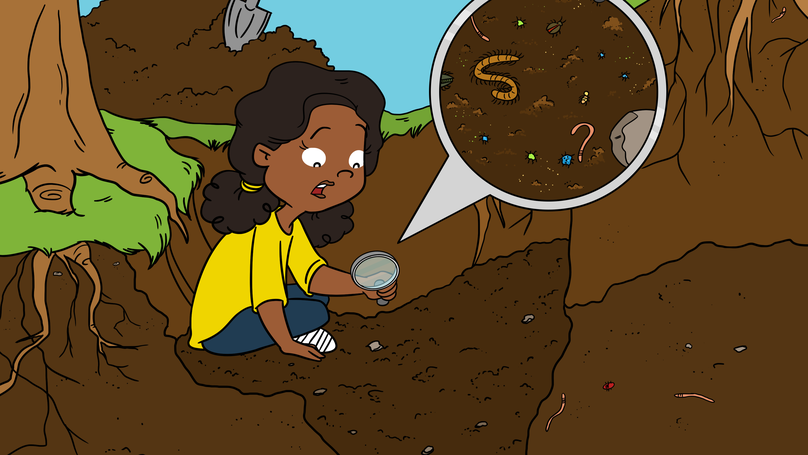
This Collection is the work of more than 50 scientists and Young Reviewers from all around the globe. Our role as editors, together with the authors, was to share our love of soil biodiversity with you. In this Collection, you will discover that soils are full of life. We will introduce some of the methods and techniques used by scientists to observe the life below our feet. We will show you that belowground life is essential to have healthy soils and, therefore, for us. However, you will soon realize that belowground life is changing and under multiple threats. The authors will give ideas on how we can protect soil biodiversity and invite you to actively help us in studying and protecting this valuable ecosystem. We have divided this article Collection into four sections, each of which is introduced below. To make our articles accessible to as many of you as possible, we have created a website hosting translations to languages other than English.

Climate change is one of the most pressing threats to humanity, inducing a global increase in temperatures and more frequent extreme climatic events. Considering this, global reforestation initiatives are proposed to capture carbon and mitigate climate change. Global restoration and reforestation programs and their targets have inspired both unparalleled enthusiasm worldwide and intense scientific criticism and debate regarding their feasibility and implementation. We agree that global reforestation forecasting and efforts require a nuanced discussion and approach. In that vein, we would like to emphasize the potential of increasing existing forest diversity to enhance climate change mitigation by increasing aboveground and belowground carbon storage. Moreover, we argue that focusing on planting diverse forests in reforestation efforts can help to reduce climate change effects on ecosystems: first, by increasing resistance and resilience to extreme climatic events, and second, by buffering microclimatic conditions in natural and urban areas. Diversifying forests plantations and reforestation projects may not always be feasible and cannot solve the climate crisis by itself. However, we highlight that a focus on diverse forests could maximize the benefits of reforestation programs by promoting sustainable land management.
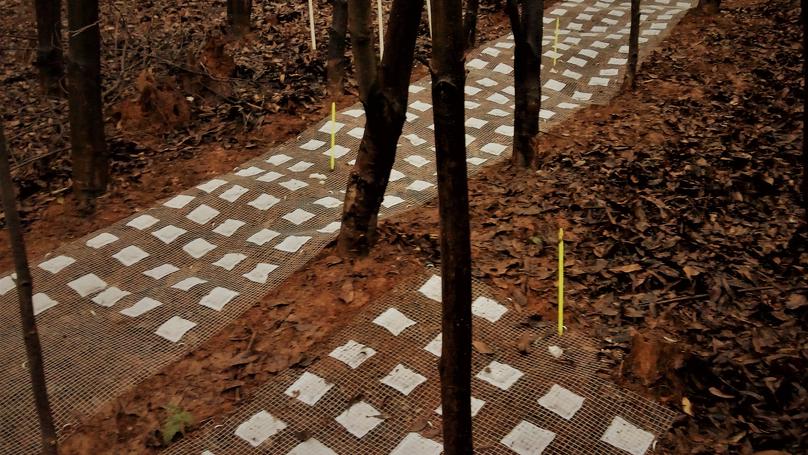
Abstract The loss of biodiversity is affecting all ecosystems on Earth, one of the greatest threats to biodiversity being climate change. Forests have been highlighted for the potential to mitigate climate change by storing carbon above- and belowground in soils.
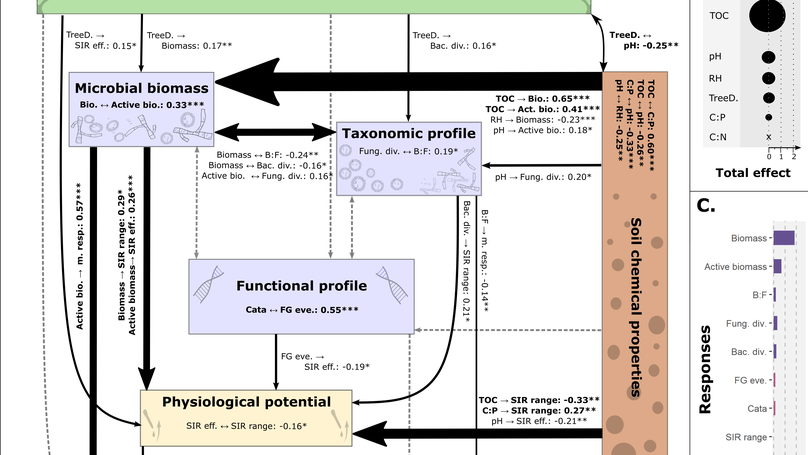
Microbial respiration is critical for soil carbon balance and ecosystem functioning. Previous studies suggest that plant diversity influences soil microbial communities and their respiration. Yet, the linkages between tree diversity, microbial biomass, microbial diversity, and microbial functioning have rarely been explored. In this study, we measured two microbial functions (microbial physiological potential, and microbial respiration), together with microbial biomass, microbial taxonomic and functional profiles, and soil chemical properties in a tree diversity experiment in South China, to disentangle how tree diversity affects microbial respiration through the modifications of the microbial community. Our analyses show a significant positive effect of tree diversity on microbial biomass (+25% from monocultures to 24-species plots), bacterial diversity (+12%), and physiological potential (+12%). In addition, microbial biomass and physiological potential, but not microbial diversity, were identified as the key drivers of microbial respiration. Although soil chemical properties strongly modulated soil microbial community, tree diversity increased soil microbial respiration by increasing microbial biomass rather than changing microbial taxonomic or functional diversity. Overall, our findings suggest a prevalence of microbial biomass over diversity in controlling soil carbon dynamics.
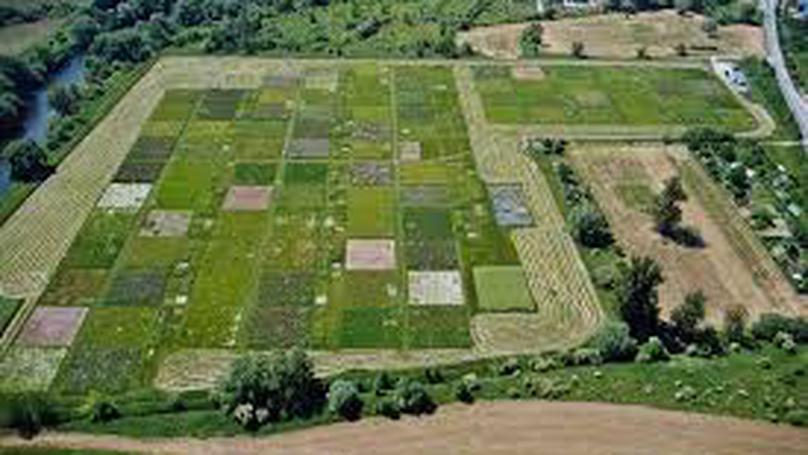
Understanding aboveground-belowground linkages and their consequences for ecosystem functioning is a major challenge in soil ecology. It is already well established that soil communities drive essential ecosystem processes, such as nutrient cycling, decomposition, or carbon storage. However, knowledge of how plant diversity affects belowground community structure is limited. Such knowledge can be gained from studying the main plant functional traits that modulate plant community effects on soil fauna. Here, we used a grassland experiment manipulating plant species richness and plant functional diversity to explore the effects of community-level plant traits on soil meso- and macrofauna and the trophic structure of soil fauna by differentiating predators and prey. The functional composition of plant communities was described by six plant traits related to spatial and temporal resource use: plant height, leaf area, rooting depth, root length density, growth start, and flowering start. Community-Weighted Means (CWMs), Functional Dissimilarity (FDis), and Functional Richness (FRic) were calculated for each trait. Community-level plant traits better explained variability in soil fauna than did plant species richness. Notably, each soil fauna group was affected by a unique set of plant traits. Moreover, the identity of plant traits (CWM) explained more variance of soil fauna groups than trait diversity. The abundances of soil fauna at the lower trophic levels were better explained by community-level plant traits than higher trophic levels soil fauna groups. Taken together, our results highlight the importance of the identity of different plant functional traits in driving the diversity and trophic structure of soil food communities.

